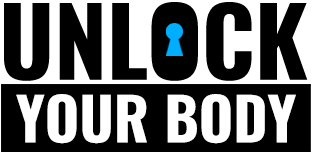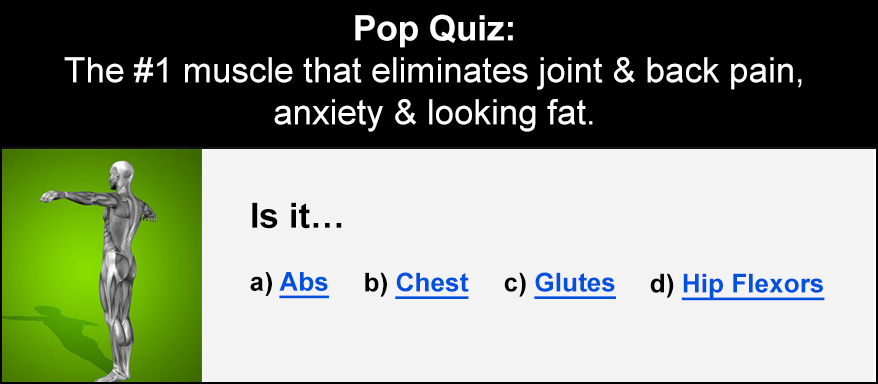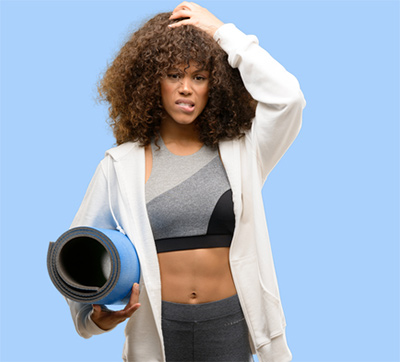
With the amount of time we’ve all been spending home recently, exercise has been a hot topic. It’s been more challenging than normal to get a good workout in, but for some it’s offered more time and energy to put towards exercise.
So, what exercise should you be doing at home if you want to stay healthy and prepare your body? These are the things we look for, and they’re the movements and plans that get you in great shape, build muscle, and prepare your joints for long-term health and happiness.
Today we’re going on a tour of these crucial exercises and the best exercises you can do at home for better health, as well as fitness…
Preparation: Setting Broader Goals
The point of preparation training is to get a wider variety of adaptations. The most common kind of adaptation exercise chases is muscle mass and strength, but good preparation means also getting other kinds of benefits.
These include things like mobility, improved muscular control, reducing injury risk, improving power, developing better posture, and strengthening tissues like the tendons/bones.
These all add up to better, more sustainable long-term results. Whether you’re looking for performance, a better physique, or improved health and wellness, the variety really helps. Preparation exercises are aimed at all of these.
This is also important during times when you have to work out at home, in preparation for heavier training in future.

Effective Exercise Choice: Principle and practice
The best exercises during this time are ones that don’t require a lot of weight to be challenging, offer ways of improving aside from what you normally train and, crucially, offer massive bang for your buck.
This is the main criteria that we’ve looked for when picking these exercises, and they fit together for full-body benefits. They are some of the best and you should continue to develop and practice them once you’re back in the gym and have access to full equipment.
These exercises tend to focus on developing control, improving range, and establishing better movement habits. They may also contribute to posture and have carry-over to other “big” exercises like the squat or deadlift.
The idea here is to get the most value for your time and effort!
Ways of Making Exercise Difficult … and Thus Better
With most of us having reduced access to gym equipment right now, the point is to develop challenge and difficulty in other ways. There are a ton of ways this is possible, and some of them are going to feature in this list. So let’s run through the most important.
Pausing: We love pausing an exercise, because it makes it more challenging and increases the demand on (and thus benefit to) stability and control. These are often lacking in most people’s workouts, so you can get a lot of value from them. We like pausing in weak positions, specifically.
Slow Eccentric: The eccentric part of an exercise is the ‘lowering’ portion where you’re working with gravity. Slowing this down improves things like control, strength, and positional awareness. All while improving technique. It’s an easy way to make simple exercises more effective and much more difficult!
Leverage: Making exercise more difficult without weight is where Gymnasts thrive. Progressing to more disadvantageous leverage, like a push up on the feet instead of the knees, is one more way of making an exercise more challenging and thus more effective.
Unilaterals: Too easy performing a movement on both your legs or arms? Then make it a one-arm or one-leg exercise. You might be surprised to find it feels more than twice as difficult!
Muscle Groups: Obviously, some muscle groups are stronger than others. Changing the muscle group you’re using, or making an exercise use specific muscles, can make it more challenging. A diamond push-up, for example, is more difficult and produces more response in the triceps.
Range: Longer ranges of motion are more difficult and more effective than shorter ones. As with stability, control over a full range of motion is often lacking in most people’s exercise, but it’s one of the ways we reduce injury risk and maximize strength/ muscle gains!
There are more options, but these are the ones we’re going to focus on most, since they are easy and contribute to a wide variety of positive changes. They’ll make your home workouts, even with bodyweight, feel challenging and effective!

Squatting/Lunging Exercises
This is a simple and easy set of exercises to practice. You should primarily be working air squats, goblet squats, and overhead squats with anything (it doesn’t need to be weighted).
These are easy and contribute to gross hip/ knee/ trunk control. These are simple, wide-reaching benefits and they make a squat worthwhile in any context!
The Cossack Squat should be present in your home training at all times. It’s one of our favorite ways of developing strength, control, and mobility. If you combine it with the single-leg exercises on this list, you’ll see great development and a continuous improvement to coordination and mobility in the lower body!
Finding depth is a great goal for times when you don’t have access to tons of gym equipment to get strong with!
Rev Lunge – Slow or Paused or Deficit
Lunging progressions are great. They offer a way of training unilateral strength and control, improving your overall sports performance and injury-resilience. They also build up strength by reducing the number of legs you’re using, making bodyweight more challenging.
You can progress from reverse lunges, which are the easiest place to start, and there are tons of varieties you can use.
The first step is to raise the front foot, increasing the range of the movement and making it more difficult, while improving core and hip control. Then you can add a weight, rotation, or even move on to more difficult single-leg exercise.

Step-Up – Explosive or Deep
Step ups don’t need a gym, they can be performed on any surface that is raised up enough to make the exercise difficult. They offer a great steppingstone between lunges and more difficult exercises, offering a deep hip and knee flexion exercise.
They’re also pretty adaptable and have the standard slow/ paused options you’d use with any other exercise. However, the options for explosive step-ups is great, with things like banded steps being another option for strength and power.
Progressing the height of the step-up is a good place to start for beginners, and allows for development of stabilizer muscles and proper technique early on. Keep the chest up, core tight, and hips square-on!
BSSq. – Slow, Paused or Deficit
This is one of the more challenging exercises you can perform for the lower body, with an elevated rear foot to really put the weight on the front leg. It’s one of the key progression tools towards challenging exercises like the pistol squat.
If you notice, this progression has been about unweighting one leg, and making the other leg take up the slack.
You can perform the Bulgarian split squat slowly, with a pause, as most other leg exercises. However, you can also elevate the front foot to increase the range and thus the challenge/results. If you can get even a little bit of weight, this makes for a challenging and effective workout by itself.
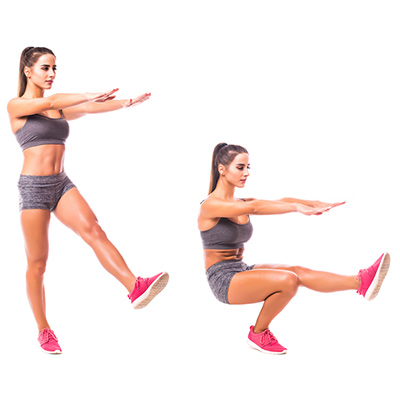
Pistol Squat – Slow or Paused
The pistol squat is pretty much the most difficult bodyweight exercise for the legs. It requires strength, balance, mobility, and exquisite control in the hips and knees. Obviously, you can cheat with a bounce, but a paused pistol squat for sets/ reps is a great achievement.
Begin with pistol box squats, lowering yourself down to progressively lower objects. I like to use a sofa as a decent pistol half-squat, but make sure you’re not sitting back and remain in control of the movement with your hips.
You can start with cushions on top of the sofa to begin with, then move lower and lower until you reach a comfortable bottom position. If this is still too hard, squat down on one leg, pause in the bottom position, then stand up with both legs.
Over time you will develop the pistol squat, especially if you’re using Cossack Squats, too. This is a great combination for well-rounded lower body development and preparation, strengthening the quads, hip extensors, and adductors.
Once you’re ready, you can add small resistance to the pistol squat. However, at this point, you’re already very strong and should be proud of that development.
Hinging Exercises
The Movement – Unweighted/ Broom
Simply practicing the hip hinge is one of the easiest and most effective ways to develop your long-term health and strength. It’s a key skill and you can never be too good at it, especially if you’re interested in heavy lifting or long-term health.
Simply practice the movement with a paused RDL, even using a broomstick. This kind of practice will add up in the long term and offers significant benefits when it comes to movement habits.
Keeping your spine straight and hinging at the hips reduces strain, putting you in better positions during everyday movements and practices.
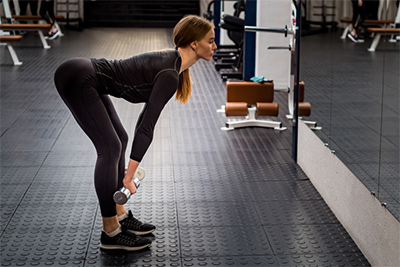
Pressing Exercises
Press Up
This is the classic pressing exercise at home. It’s a bodyweight movement with a ton of variations that offer something useful to you, regardless of how strong or experienced you are.
The wall push-up, knee push-up, and incline push-up all offer beginners a way to progress. These strengthen the key muscles (triceps, chest, and shoulders) without the same difficulty and will allow you to progress to full push-ups over time.
From here, the normal push up is great, while slow descent can be a great choice, and hand-release push ups are great for involving the upper back in the movement. These are fundamental skills for pressing with bodyweight, or with resistance.
To make things more difficult, you can add a general deficit or perform a press up on blocks. These both increase range and the load that goes through the shoulders, rather than the toes/ knees. You can switch to diamond push ups for more tricep work, or to Maltese or wide-grip push ups for the chest.
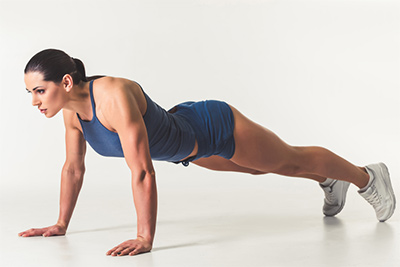
Dip – Seated or Ring
The “seated” dip performed on a sofa or similar surface can be a great way of training the shoulders. Especially when performed slowly and under control, it can prepare you for better range and strength, building mobility and performance as well as muscle mass.
These can be scaled by how much of your weight is put through the feet, and made more difficult by elevating the feet on a chair or box. These allow you to tailor the difficulty of each rep and focus on practice, control, and rep work before loading your muscles and joints more heavily.
This is good for combining with the press up due to the varied effects and joint angles. This also leans into the shoulders and chest more, with increased range for these muscles, specifically.
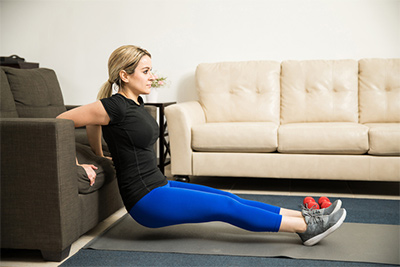
Pike Pressing – Angles and Difficulty
If you’re really into pressing with bodyweight, the pike press is awesome. It’s a step on the way to a handstand press up and one of the most effective upper-back strengthening exercises you can do at home, second only to pull-ups.
This is a fantastic variation that is seldom used but provides amazing loading, scapular control gains, and is a step up on the difficulty from standard pressing movements.
As you might be able to tell, we like this exercise! It’s a way of developing different kinds of strength and control than you’d usually see in beginner bodyweight exercises.
Core Exercises
Stability and Limb Isolation
We’ve discussed spinal stability and limb isolation before. These are types of exercise that strengthen the neutral spine position, and limb isolation exercises practice maintaining that position while also moving the limbs.
We’ve covered a whole article on this, so check that out. However, you should be practicing planks and side planks for spinal stability in 3 dimensions, especially with twists, dips, or walk-ups.
Exercises like dead bugs and bird dogs are key for spinal stability and ensuring proper long-term performance in core-demanding exercises. If you want to squat and deadlift and run well, these are underrated tools in your training toolkit!
You should also look at limb isolation exercises that improve the control of hip rotation – both internal and external. We’ve already mentioned why it’s key to develop in both directions, but this is also important while maintaining core stability, especially for heavy lifting where collapsing knees is a real problem!

Rotation Tings
While exercises like deadbugs and bird-dogs are rotational, you can also focus on more specific ways of developing rotational core strength.
Side planks with a twist are the best place to start since they ensure proper overall core activation and you can’t cheat them. These should be combined with traditional Russian twists to get the best of both worlds.
Additionally, if you have a small weight at home, you can keep the lower body stable and perform straight armed rotations to increase the difficulty. Remember to move slowly as you get closer to the floor because those end ranges are where you need the most control.
You can also have someone gently push down on your arms or legs, alternatively, if you have a willing family member, but no weights.

Closing Remarks
The development of well-rounded strength and preparedness comes from being diligent with the little things. The movements you can perform at home without equipment offer a way of filling in the gaps and improving your overall performance.
They keep you safe, reduce injury risk, and help you look and feel better. These are a great investment of your time and offer a variety of benefits you might not be able to get through the bit, ‘meaty’ exercises you tend to see in the gym.
Mixing it up with this kind of at-home prep work is a great way to prepare for long-term gains ad ensure you’re giving your body everything it needs.

